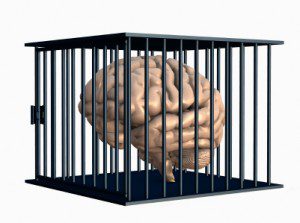
I’ve been digging into learning styles and “learning to learn” lately, and in the process keep bumping into three bits of conventional wisdom about the human brain that, in fact, are not as clear cut as people often think they are. I highlight them here not because there is no truth to them, but because people have a tendency to give them far too much weight, and in doing so, erect barriers to their own learning. Here they are:
Left Brain vs. Right Brain Thinking
You know how it goes: The left brain is logical and analytical; the right brain is spatially-oriented and creative. Careers and fortunes have been made off of this one, and people tend to get passionate about it. But the real story is much more complex. While there are clearly differences in how the hemispheres of the brain process sensations, neither side is “specialized” to the degree that more popularized left brain/right brain theories suggest. A normal brain acts in an integrated fashion whether it is focused on painting a masterpiece or analyzing a profit and loss statement.
Granted, you may not be the next Picasso, but it is highly unlikely your artistic shortcomings stem from the fact that one side of your brain is dominating the other. A variety of other factors have a role, and the simple fact is, just about anybody can draw, paint, or perform any number of other creative acts reasonably well with a bit of training, discipline, and a sincere will to learn.
Just do a search on “left brain right brain myth” and you will find plenty to read, but I also came across this succinct list posted by Gary Platt on the TrainingZone UK site (the original list contains additional links, but I eliminated three that appear not to function any more):
- ‘Right Brain’ or ‘Left Brain’ – Myth Or Reality?
- In Search of…Brain-based Education
- Drawing on The Right Side of The Conclusions
If you’d still like to have some fun testing out your right brain/left brain and general thinking preferences, I suggest:
There is a “Critical Period” for Learning
I have felt the burden of this one as someone who took up the study of various languages and musical instruments relatively late in life. The idea is that there is a window early in life when a person is much more capable of learning certain things—second languages, including music, tend to be highest on the list—and that the window more or less closes at some point, usually around the onset of puberty.
Well, as with the right brain/left brain phenomenon, the truth is significantly more complex. Few who study such things dispute the idea that younger brains have certain distinct advantages in mastering complex systems like languages. The question is what happens to these advantages as people get older. Does the “window” really close at some point as we all turn into proverbial old dogs who can’t learn new tricks?
In certain limited ways, yes. For instance, we don’t tend to pick up the phonological aspects of a language nearly as easily as we get older. This means most of us butcher the accents of new languages we pick up as adults. But we can still master grammar and acquire new vocabulary. And how well we can do these things depends on a variety of factors ranging from personality to motivation to a range of environmental factors. In short, our ability to learn a new language does not cut off at a certain age. Perhaps more importantly, there is little, if any, evidence to support the idea that our ability to learn things besides languages cuts off or even declines all that substantially as we age.
Let’s face it: If you are really interested in learning, the “critical period” is now.
Old Brains Don’t Change
Notions of brain “plasticity”—i.e., the ability of the brain physically to change and grow over time—are closely related to the “critical period” theory above. It used to be believed that the neural connections in our brains, or at least in certain parts of our brains, became fixed as we aged and then eventually began to erode. We now know that the brain can continue re-wiring itself and changing well into old age and that in certain areas of the brain—the olfactory bulb and the hippocampus—the brain actually has the ability to generate new cells throughout adulthood.
Experience alone drives much of the reorganization of neural connections that occur over time. We adapt to new environments (the social Web, for example) and build up new connections to meet the challenges that we encounter in our everyday life and work activities. But an active focus on learning can accelerate and augment this process. Some research even indicates that a consistent focus on cognitive activity helps to generate a “brain reserve” that can help defend against age and disease-related damage. Of course, this is an idea attractive to so many people that a whole industry is growing up around it, so keep a few grains of salt on hand if you head out onto the Web for more information in this area.
As with critical period theory, the brain’s ability to change and grow throughout life doesn’t mean that the young—particularly the very young—do not possess a biological advantage when it comes to raw learning capacity. But neither do the young bring the experience and judgment to the game that we older learners possess. Part of the challenge for older learners is not to let oversimplified conventional wisdom cloud our judgment and box us in. The brain enables a great deal, if we let it.
JTC
P.S. If you enjoy what you read here on Mission to Learn, I encourage you to subscribe to the RSS feed or use the e-mail subscription form at the top right side of this page.




